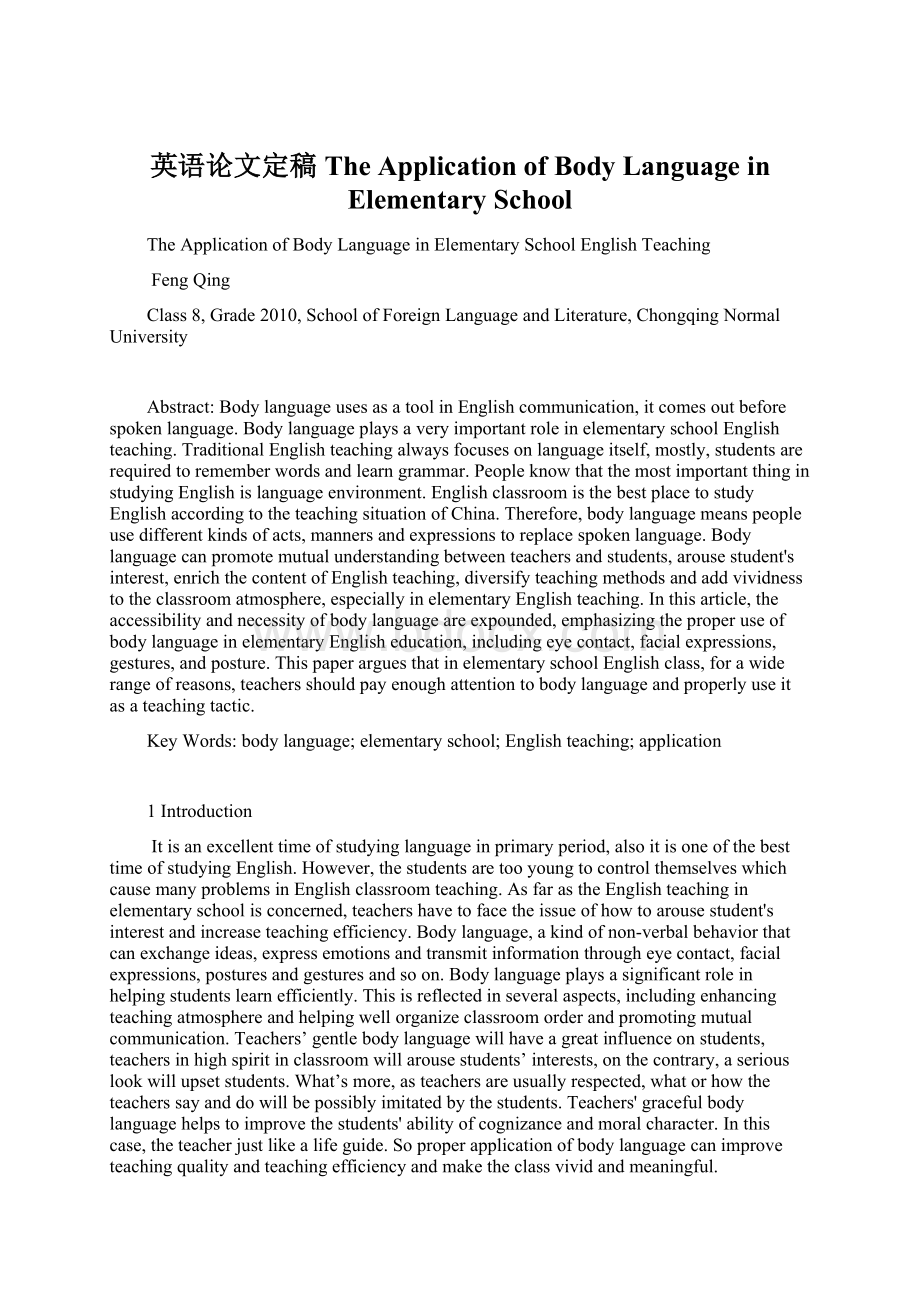英语论文定稿The Application of Body Language in Elementary School文档格式.docx
《英语论文定稿The Application of Body Language in Elementary School文档格式.docx》由会员分享,可在线阅读,更多相关《英语论文定稿The Application of Body Language in Elementary School文档格式.docx(7页珍藏版)》请在冰豆网上搜索。

BodylanguageusesasatoolinEnglishcommunication,itcomesoutbeforespokenlanguage.BodylanguageplaysaveryimportantroleinelementaryschoolEnglishteaching.TraditionalEnglishteachingalwaysfocusesonlanguageitself,mostly,studentsarerequiredtorememberwordsandlearngrammar.PeopleknowthatthemostimportantthinginstudyingEnglishislanguageenvironment.EnglishclassroomisthebestplacetostudyEnglishaccordingtotheteachingsituationofChina.Therefore,bodylanguagemeanspeopleusedifferentkindsofacts,mannersandexpressionstoreplacespokenlanguage.Bodylanguagecanpromotemutualunderstandingbetweenteachersandstudents,arousestudent'
sinterest,enrichthecontentofEnglishteaching,diversifyteachingmethodsandaddvividnesstotheclassroomatmosphere,especiallyinelementaryEnglishteaching.Inthisarticle,theaccessibilityandnecessityofbodylanguageareexpounded,emphasizingtheproperuseofbodylanguageinelementaryEnglisheducation,includingeyecontact,facialexpressions,gestures,andposture.ThispaperarguesthatinelementaryschoolEnglishclass,forawiderangeofreasons,teachersshouldpayenoughattentiontobodylanguageandproperlyuseitasateachingtactic.
KeyWords:
bodylanguage;
elementaryschool;
Englishteaching;
application
1Introduction
Itisanexcellenttimeofstudyinglanguageinprimaryperiod,alsoitisoneofthebesttimeofstudyingEnglish.However,thestudentsaretooyoungtocontrolthemselveswhichcausemanyproblemsinEnglishclassroomteaching.AsfarastheEnglishteachinginelementaryschoolisconcerned,teachershavetofacetheissueofhowtoarousestudent'
sinterestandincreaseteachingefficiency.Bodylanguage,akindofnon-verbalbehaviorthatcanexchangeideas,expressemotionsandtransmitinformationthrougheyecontact,facialexpressions,posturesandgesturesandsoon.Bodylanguageplaysasignificantroleinhelpingstudentslearnefficiently.Thisisreflectedinseveralaspects,includingenhancingteachingatmosphereandhelpingwellorganizeclassroomorderandpromotingmutualcommunication.Teachers’gentlebodylanguagewillhaveagreatinfluenceonstudents,teachersinhighspiritinclassroomwillarousestudents’interests,onthecontrary,aseriouslookwillupsetstudents.What’smore,asteachersareusuallyrespected,whatorhowtheteacherssayanddowillbepossiblyimitatedbythestudents.Teachers'
gracefulbodylanguagehelpstoimprovethestudents'
abilityofcognizanceandmoralcharacter.Inthiscase,theteacherjustlikealifeguide.Soproperapplicationofbodylanguagecanimproveteachingqualityandteachingefficiencyandmaketheclassvividandmeaningful.
Bodylanguageisalsoatooltohelpexplaindifficultknowledgetostudents.Theimportanceofbodylanguageisconsideredtohelpstudents’understandingandcreateahappy,softandmorecomfortableclassroomenvironment.Sometimes,theoryknowledgeisahardparttoteachtostudents,butbodylanguagecanchangethetheoreticandabstractknowledgeintothesimple,andaccessiblegestures,whichismorespecificandfigurativeandmucheasierforstudentstounderstandandrealize.Tobeconcluded,thestudents'
interestismotivatedandtheeffectofteachingisimproved.Alotofpracticeshaveprovedthatthesuccessfulclassroomteachingbasedonnotonlytheteachersgracefullanguageexpressionbutalsothenaturalanddecentbodylanguage,theyareindispensableparttooneanother.
Thispapercanbemainlydividedintothreeparts.Thefirstpartprovidessomedefinitionsofbodylanguagegivenbysomefamousexperts.Inthesecondpart,ittendtoshowtheconcreteapplicationofbodylanguagethrougheyesight,facialexpressions,gestures,andpostureinelementaryschoolEnglishteaching,combinedwiththeanalysisoftheaccessibilityandnecessity.ThelastpartshowsthesignificanceofapplyingbodylanguageinelementaryschoolEnglishteaching.
2Thedefinitionofbodylanguage
Manydefinitionsofbodylanguagehavebeenbuiltbyexperts.Somedefinitionsaregeneral.Forexample,bodylanguageisdefinedasalanguagewithoutwords;
orbodylanguageindicatesallcommunicativesymbolsexceptoralspeech.(Harrison,R,1974:
133).Itbelongstonon-verballanguage.Somedefinitionsarespecific.Forexample,SamovarandPorterholdsuchidea:
"
Bodylanguageisthespecially,biologically,psychologicallyorculturallyframedexchangeofvaluablemessageswhicharenotverballyspokenoutbutconveyedbythebody,gesture,symbolorrelevantcontextandsurroundingenvironmentetc."
(Samovar,L.&
Porter,R,1995:
14).
AccordingtoBirdwhistell,thestudyofnonverbalcommunicationcoversthreemajors:
Proxemics,Paralanguage,andKinesicsorBodyLanguage.(Birdwhistell,R,1952:
56).Proxemicsmeansthatpeoplekeepacertainspaceordistancewitheachotherwhentheycommunicateandthatthedistancecanrepresentdifferentsignificance.Paralanguageinvolvesthelinguisticelementsofspeech--howsomethingissaidandnottheactualmeaningofthespokenwords.Itistotransforminformationbysound,suchas"
Ouch"
.Besidesthis,thepitchoftoneandvolumeofspeakingalsobelongstoParalanguage.KinesicsisalsocalledBodyLanguage,whichstudiesthemeaningofallpartsofbodyandhowbodymovementcommunicatesmeaning.(Birdwhistell,R,1952:
154).
3TheapplicationofbodylanguageinelementaryEnglishteaching
Inthepaper,itdefinesbodylanguageasaseriesofphysicalmovementsthatcansendinformationeffectivelywhencombinedwithverballanguage.ConsideringthespecialtyofEnglishteachingactivities,weclassifyitintoeyecontact,facialexpressions,gestures,andposture.
Inclass,theteacher'
sbodylanguagechieflyincludeseyecontact,facialexpressions,gesturesandposture.Differentclasssituationshavedifferentbodylanguages.Accordingtothepupil'
slivelycharacters,teacherscanapplygestures,expressions,etc.asmuchasnecessary.Forinstance,whenteachingthemeaningofword‘jump’,teacherscanfirstwritethewordontheblackboard,thenjumponceandaskstudentstoguesswhat’sthemeaningofit.inthisway,pupilscanlearnthismoreeasily.Inaddition,teachersavoidspeakingChineseinordertostrengthenpupil'
sperceptualknowledgeoftwolanguagesandpavethewayforfuturestudy.
3.1Teachers’eyecontact
Pupilsattitude,emotion,andinspirationareinfluenceddirectlybyteacher’seyesight.Positiveeyesightreflectsconcernandencouragementfromteachersanditensurestheformationofconfidenceinstudents.Onthecontrary,negativeeyesighthurtspupils'
confidence.Inshort,lovingandkindeyesightoftengetintothestudent'
smemoryalongwiththeteachingcontent.Sucheyesightandteacher'
sgoodmoralqualitycandeeplyinvolveinthestudent'
smind.Inaddition,teachers'
eyesightconsistsoflookingaroundandlookingattentively.
3.1.1Lookingaround
Lookingaroundhasaconventionaleffectonstudents.Whiletheclassbellisringing,theteachercanstandontheplatformandlookaroundtheclassroom,suggestingtothepupilsthattheclasswillbeginandit'
stimetobequiet.Thismethodismoreeffectivethanteachers'
shouting,"
Quiet,please!
"
Intheprocessofinstructing,occasionallylookingaroundtellsthepupilstolistenconscientiously,becausetheteacherisobservingtheirindividualperformanceintheclass.That'
swhytheforeignlanguageeducationistsbelievethatateachershouldlooksteadilyateverystudentwhilehavingaclass.Itmeansloveandequalityanditcanmakethestudentsrealizetheirteacher'
svaluableconcern,whichcanraisethestudents'
dynamicroleofstudy.Furthermore,teachersshouldtrytoestablisheyecontactwiththeentireclass,notjustwiththefrontroworonlyoneortwostudents.Teachersalsoshouldnotonlystareatthestudentwhoisgoingtobeaskedaquestion,becauseitprohibitslettingallthestudentsthinkaboutthequestion.Theteachershouldpresentbalancedeyesightandlooktotheback,front,fromsidetosidearoundthewholeclass.
3.1.2Lookingattentively
Lookingattentivelyreferstotheeyesgazingatstudentsforaquitelongtime.Itisdividedintoseriouslooking,intimatelookingandnecessarylooking.(Harrison,1974:
232).Duringexaminations,teachersusuallyadoptseriouslookingeyegazetopreventstudentsfromtryingtocheat.Intimatelookingtendstobeusedinnormalclassroomsituations.Themomenttheteachersstandontheplatformdisplaying"
sweet"
eyesight,pupilswillfeelascomfortableandatease.Thisinformalandrelaxing"
introduction"
indicatesthebeginningofajoyfulclass.Ifsomepupilsfeelnervous,thisformofeyesightalongsideasmilewillaidingettingridoftheirworries.Andalsobywatchingtheeyesofstudentsandlettheeyeshelpinterpretlanguage,organizetheteaching,transfertheinformationandexpressthefeeling.
3.2Teacher’sfacialexpressions
Ourfacesplayakeyroleinexpressingourthoughts,especiallyouremotionsandattitudes.Accordingtoseveralcross-culturalstudiesmadebysocialpsychologistPaulEkmen,people'
scountenancesshowtheiremotionalexpressionsclearly.Therefore,teachersshouldaimatunderstandingthedifferentsituationsthatappearintheEnglishteachingclassroom,andbeabletotalkandperformusingtheirfaces.Usingtwoteachersasexample,twoteacherswhodisplayedentirelydifferentperformanceduringthe